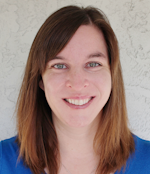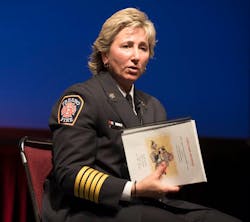FHWorld16: Fresno Fire Chief Donis Addresses Cortland Incident
In a special late-addition to the Firehouse World session lineup, Fresno Fire Chief Kerri Donis sat down with Firehouse Editor-in-Chief Tim Sendelbach to discuss the Cortland Incident in which Fresno Captain Pete Dern was critically injured, as well as the newly released Multi-Agency Serious Accident Review Team (SART) Investigation Report on the incident.
In front of hundreds of fellow firefighters and conference attendees, Donis was forthright about the issues that she believes played a role in the March 29 incident, including department culture, staffing cuts and high turnover in leadership positions.
On March 29, Dern was operating on the roof of a garage when it gave way and he fell into the flames. He suffered second- and third-degree burns over 70 percent of his body and ultimately spent 164 days at a burn center recovering from his injuries. The incident garnered national attention. “No one in our department had every experienced a near miss like this—ever,” Donis said. “We were blessed that he walked out of the hospital.” Dern is doing well but still in recovery.
Approximately one week after the incident, Donis asked for a thorough investigation that could drill-down on concrete recommendations. “The goal is that this never happens again,” she said. The investigation involved multiple agencies and a variety of SART members, including chief officers and captains from like-sized departments, and a representative from the local union. The report also reviewed 77 NIOSH Review Reports from fire fatalities over the past 10 years in order to identify common themes.
Just prior to the release of the 274-page report, Donis had an opportunity to review the findings. “I was overwhelmed by the breadth and depth of the work we had to accomplish,” she said. “It was stunning."
Central to the SART finding was the need for a cultural change at the Fresno Fire Department. “Yes, we have an aggressive mentality,” Donis said. “But we have to be aggressive and safe and smart. Saving four walls and a roof at your own expense is not worth it.” She later noted that, “We have this ‘4 Minutes to Excellence’ mentality. It’s rush, rush, rush through the process,” which she recognized could have played a role in some of the safety issues identified din the report.
Donis also acknowledged the role of the economic downturn that led to department cuts, including the training budget. She recalled times when firefighters were receiving computerized training that likely resulted in no real learning, as well as the fact that the department no longer had a Captain’s Academy. Following Dern’s near miss, Donis was quick to go to local officials to frame for them “why bad things happen to good departments,” underscoring the need to invest in a training division and increase resources and staffing. “The mayor didn’t blink,” she said. “She said ‘let’s figure out how to fund it.’”
Donis talked through how the department handled the incident and some lessons learned. She started with some of the immediate actions she took, which included informing the mayor of the incident, and putting six of Pete’s close friends from the department on special assignment so they could have the time to be with Pete and their families. They also began setting up a schedule for helping Pete and his friends’ families with everyday tasks so they wouldn’t have to worry about things like cooking or cleaning during a time of crisis. The department set up a critical-incident stress management (CISM) team within six hours of the incident to help everyone involved.
Donis explained the need to for the chief to be involved following an incident of this magnitude. “You have to be present and insert yourself, even if others don’t want you there,” she said. “If you are a chief officer, you have to understand that this is a lonely position in a department. But we’re in this together, and you have to show up and be there for each other.” She added that the words “I love you” were expressed a lot in those first few days as the entire department dealt with the tragedy. Further, she called each member of the first-alarm assignment on a regular basis for the first several weeks after the incident, she said.
The firefighters who were at the incident were granted immunity, she said, so they would speak freely to the investigation team. “There was no discipline that was going to be of value” in this situation, she said. The key was getting an authentic detailing of what happened so the department could learn and implement meaningful change.
What Donis learned from that open communication shocked her. She was apprised of a few things in particular long before the report came out because the team felt it was important that the chief be immediately aware of some of the information being shared with investigators, namely that some firefighters reported not wearing full PPE or seatbelts on calls, and a lack of understanding of how to properly use the radios for communications on scene.
Within days of learning of these safety concerns, Donis issued a memo in conjunction with the Local 753 president explaining that wearing full PPE and seatbelts were non-negotiable. They also began working on how to address issues with the radio, both the technical/mechanical issues and the human factor.
When Sendelbach asked Donis about how she can ensure accountability for these specific safety concerns and others, she explained that the key is to hire courageous leaders at every rank—leaders who will hold their members accountable so it permeates the ranks.
A member of the audience asked Donis about how to keep the momentum of change moving in the right direction after an initial burst of attention and funding. She explained that it simply comes down to being persistent. “It takes a lot of hard work to frame your message for your constituency—a lot of energy to get them to understand why this is a value,” she said. She added that local officials have continued to be very supportive, and even agreed to replace their entire fleet within 8 years and add back support staff positions. She said the training staff has been doubled as well, and Sendelbach offered free conference passes to the training staff to attend Firehouse World 2017 in order to help support the healing process.
Sendelbach, as well as several firefighters in the audience, thanked Donis for her directness about the incident, commending her willingness to talk so openly about a difficult situation. She reiterated her clear intentions to make significant improvements at the department. “I wouldn’t be doing this [speaking at Firehouse World] if I didn’t intend on following through on the report,” she said. “We are going to turn this around. We are going to be relentless.”
Donis also pointed out to attendees that the SART report could be their “playbook,” and encouraged attendees to have courageous conversations about their own departments so they don’t have to experience the same tragedy.
The SART report is available to read or download here.
More from Firehouse World 2016
- Photos: Day 1 - Future Firefighter Program
- FHWorld16: Firehouse Ambassadors Get Lessons in Values
- FHWorld16: Fireground Air Management - A US/UK Perspective
- FHWorld16: Building a Robust Fire Dynamics Training Program
- FHWorld16: The Halligan Is a Valuable Tool on the Fireground
- FHWorld16: Sendelbach Poses Challenge to Fire Service
- FHWorld16: Chief Hood Says It's 'Time to Own It'
- FHWorld16: Leading Health Risks on the Modern Fireground
- FHWorld16: An International Look at Firefighting
- Photos: Day 2 - Firehouse World 2016
- FHWorld16: Strategies & Tactics for Residential Attic Fires
- FHWorld16: Safety in the Decision-Making Process
- FHWorld16: Trust Between Officers, Chiefs Critical to Fireground Operations
- FHWorld16: Weathering Organizational Change Takes the Efforts of Many

Janelle Foskett
Janelle Foskett served as editorial director of Firehouse Magazine and Firehouse.com, overseeing the editorial operations for the print edition along with working closely with the Web team.






